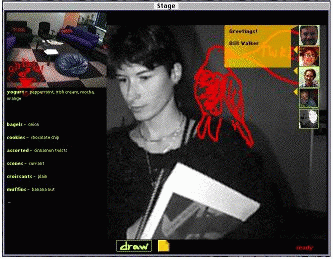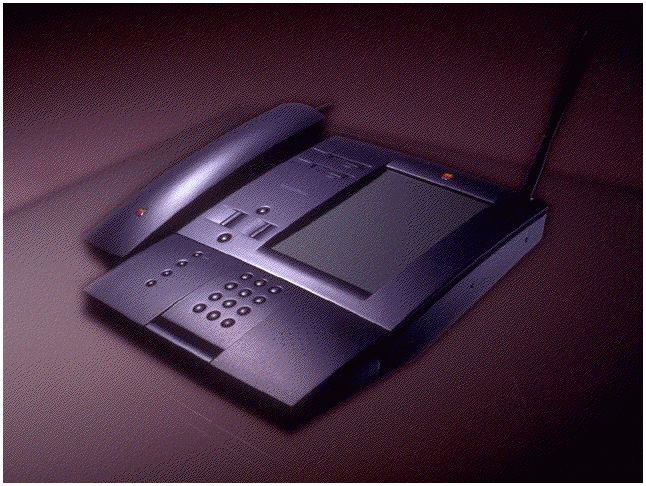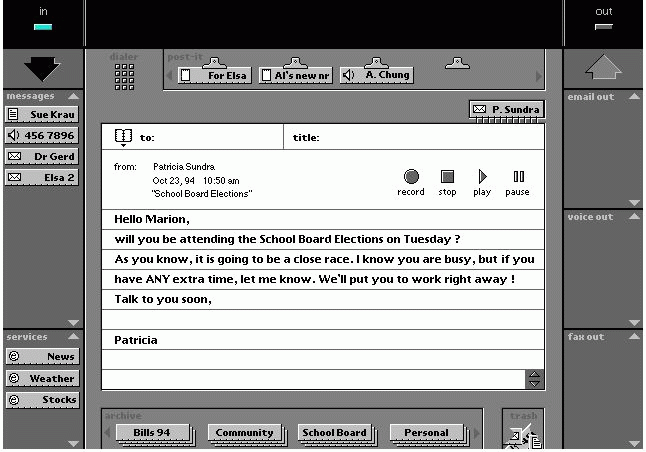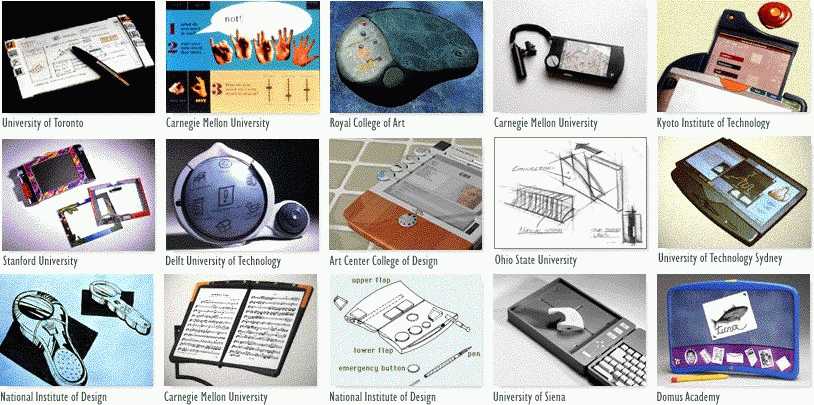Issue
Article
Vol.30 No.2, April 1998
Article
Issue
Issue |
Article |
Vol.30 No.2, April 1998 |
Article |
Issue |
The idea of user experience is to take care of, account for, design and consider everything the user uses. Creating a useful and enriching user experience is an encompassing goal that necessarily crosses specialty boundaries in the pursuit of a single, unified, coherent experience of the computational.
The User Experience Research group was formed within Apple's research labs as a multidisciplinary group to study and design new kinds of complete user experiences.
Late in 1994, the Human Interface Group (HIG) disbanded following a complicated set of shifts in personnel and research directions. Since the user interface is such an important aspect of the Apple product line, a new group was set up to re-start work in this area.
The User Experience Research (UER) group was established with the explicit goal of bridging the gap between design domains (graphical, interaction and visual) and systems building for implementation. Beginning in 1995, UER always had an emphasis on user studies, speculative design, implementation and learning from the experiences of deployment.
UER focused on understanding the wide-ranging user-centered issues of computation. This work included:
and others that remain as yet within the Apple pool of undisclosable art.
The members of UER spanned the spectrum from system builders to visual designers to cognitive scientists. From this overtly multidisciplinary approach we focused on the basic issues of creating new kind of UE -- that is, a User Experience could be designed that incorporates lessons from the user interface, but also takes into account many other factors as well -- the physical design of the system, settings of use, metaphor design, and expectations about the system.
UER took a very pragmatic approach as its working style. Typically a project began as an investigation (a good idea or suggestion in the air) that would evolve into exploratory designwork (creating and using prototypes of whatever fidelity needed) and become a prototype. Typically, working systems would be incrementally released: first to the members of UER, then to local members of the laboratory, then to the ATG level and on outward. Incrementally expanding rings of users meant we could resolve issues and clarify our thinking before getting too far down the implementation track.
During the three years of UER, we worked on a number of projects. The essence of the work was to deeply change the way people could use the Macintosh computer.
One of UER's primary interests was in how a workgroup could more effectively share information about their joint work. A number of projects explored the ideas of sharing working status information in realtime.
OhLaLa -- Like many others with web-based intranets, we built a station with camera and placed it in Apple's central espresso stand on the main campus. Along with the image of the coffee line, the bagel-of-the-day and yogurt-of-the-day flavors were given by the OhLaLa staff.

OhLaLa: The server gave a view down the coffee line by snapping a video still every minute or so. Passersby could draw atop the video or leave messages for friends by connecting to the server as though it were a shared chat session.
As an exploration into creating a shared awareness of the communal coffee line, the service worked quite well. The visual and interaction design were very attractive, and on the whole, there were few problems in introducing the video presence into Apple's open and public environment. (But the introduction was done with some care. See [Bellotti, 96] for the concerns we were worried about.)
Unfortunately, the client-side software was somewhat too heavy-weight to coexist naturally with other applications on a primary working system. The constant image updates and running commentary also proved to be fairly distracting.
The perceived weight of the system gave us an interesting data point in our prototyping experience: a beautifully rendered, wholly operational system (but one that dragged down the overall system performance) gives a certain kind of experiential data. A prototype can only tell you what it can deliver within its performance limits: extrapolating beyond that boundary is a chancy affair [Rettig, 94] [Virzi, 89].
Shared Information Service -- It became clear to us that we needed an infrastructure for rapidly prototyping shared awareness applications. The Shared Information Service (SIS) was an almost-realtime database system that tracked changes in real-world data. When a change happened, it propagated the newly changed information around to clients that were interested in the changes.
As noted in [Walker, 97], this kind of "push technology" can become a valuable basis on which to build all kinds of tools for sharing awareness. By centralizing much of the needed infrastructure (and by providing a very convenient remote API), prototyping a shared application became a relatively straightforward exercise.
By adding a relatively large collection of door sensors, motion detectors, application monitors and phone state detectors, SIS could maintain a fairly elaborate picture of what was going on within the workgroup at any time.
Central to the way UER worked together was to draw on in situ studies of potential technology users. Somewhat unusually, the user studies described here were both influenced by, and directly influenced the work of the UE designers and system implementations.
More importantly, user studies have simply been the style of the group. It is the way we approached shared awareness and group work problems.
The Telework study was an investigation into how people working remotely would organize their work day and information practices [Bellotti, 96]. This laid the groundwork for understanding the basic characteristics of computer users in their home environments, and informed UER of the primary activities, methods and types of work conducted in a remote setting.
The Multimedia Publishing study investigated similar kinds of questions in the production rooms of newspapers and new media publishers. Here, the pressures of constant production lead to adopting solutions in the absence of good practice. Workers need support for system qualities such as workflow, but frequently have to piggyback atop extant resources (e.g. using a file system by overloading file hierarchy semantics and filenames) [Bellotti & Rogers, 97].
Distributed collaboration & mobility study -- This was a detailed study of how people organize their work spaces when collaborating and when very mobile. Here, findings include observations about organization principles -- primarily, that the organization of content is key to work efficiency; that keeping space free and assisting in retention is an essential aspect of organization systems, as is the easy retrieval of information. In the physical worlds studied, work is often organized by task (that is, items and tools collected together in single space) into "piles" or easy-to-manipulate pools. In addition, people want to preserve ambiguity and postpone decisions, realizing that overt up-front organization frequently does not pay off in use [Bellotti & Bly, 1996].
Organizers -- These kinds of user observations led UER to a long-term investigation into ways of constructing entirely new ways of placing task organizations into the computational user experience [Hill & Ward, 97]. "Organizers" was a proposed basic re-construction of the Macintosh along task-centered lines, while emphasizing a very small number of essential organizing elements and viewing mechanisms. (See also [Erickson, et al., 96] for a larger view of these ideas.)
NetScan -- As an interim solution to the organization problem, Blake Ward wrote an AppleShare network full-text indexer and query service [Ward, 97]. Built atop the V-Twin full-text analysis engine [Rose & Stevens, 97], and by using Apple Filing Protocols not found in TCP/IP, NetScan can identify all servers on the network (including printers, database servers as well as guest-accessable workstations and file servers) and full-text index any text found therein.

NetScan: The NetScan client communicates with the indexing server over the network. In response to user queries, NetScan can find printers, calendar servers, files, folders and text in files.
Most notably, after successfully rolling out NetScan from UER to the local group and then to all of ATG, serious security concerns we raised moments after NetScan was available to all of Apple. Suddenly, it became dramatically simpler to find almost anything that was publicly available. Before NetScan, a broad-based find was simply impossible due to the sheer number of servers and workstations. As a consequence, many network citizens were relying on "security through obscurity" -- that is, because the intranetworked file system was so large, the chance of someone stumbling across an unsecured (but important) document was virtually nil. With NetScan, it was possible to search for text such as "private" or "confidential" in a matter of seconds.
We withdrew NetScan services for a few weeks until an Apple-wide tightening up security awareness program could be made widely known. After working closely with Apple security and the internal Apple news producers, NetScan was reinstated and continues to serve.
Several projects were specifically joint work with production teams. From an Apple-wide perspective, exchanging people between research and production was an ongoing process. Several times during the early 1990's entire research teams moved from ATG into product groups.
Another style of working with production was to conjointly work on a project. UER worked with the Industrial Design group on an exploration into understanding the effect that a product's industrial design would affect the product's interpretation and sense of perceived value by customers.
The Trimline Project created several "rhetorically" different versions of the same product. This hypothetical product was a multifunction fax / phone / email / printer combination that was rendered in three widely varying form factors. Each of the forms was implemented in very high-fidelity plastics, and a functioning software interface was created for evaluation purposes.

Trimline: This ID model was used to evaluate the user perception evoked by the physical form in conjunction with the operational software. This multifunction device captured the sense of a high-end system, yet had a lower expected price point than a pure software solution.
UER and the Industrial Design groups created the models, wrote the software and studied prospective buyer reactions to each of the devices. It became clear in the process that creating a clear rhetorical statement of the end product was valuable for the designers involved. Further, the final products were clearly perceived as being substantially different. Unfortunately, the study revealed that the anticipated price points for each device were not aligned with anticipated production costs or margins.
Japheth was a planning system based on the least-commitment planning ideas of [Weld, 94]. A user-specified goal would be given to Japheth (e.g., "Open this URL"), and the planner would generate the sequence of steps necessary to achieve the goal.

Trimline UI: Each model created had a high-fidelity plastics model along with a functional UI created in Director\xa8 . The test subjects could see and interact with the device, just as though it were nearly fully functional.
In a larger sense, Japheth was an attempt to radically simplify the growing complexity of the user interface by creating a software agent to take charge of complicated actions.
And while Japheth demonstrated that such an approach is possible, it was never directly incorporated into a product. On the other hand, its architecture and representational system heavily influenced the design of tools that are now used to create online help systems.
Apple Design Project: Apple believes that interdisciplinary design plays a fundamental rolein addressing the opportunities and challenges posed by rapid technological change. Design has a key role to play in exploring the potential uses of technology, understanding and managing its impact on society, and ensuring that it is accessible, usable, and useful.
Design practice is ultimately experiential. The best way to learn it is to participate in it.The goals of the Apple Design Project have been idealistic and hopeful: to instill a sense of user-centered design in the sensibilities and practices of young designers.
Since its inception in 1992, the Apple Design Project has brought scores of schools and hundreds of students to Apple for a one week intensive session. During the week, Apple staff designers and UE literati from the community came together to review, critique and prepare the projects for a public presentation. In this short amount of time, beginning designers gained a great deal of exposure of their ideas, and solutions. They heard the analysis, and reviewed the answers found by their peers to the same design problems.

ADP: Over the years, a wide variety of schools have participated in the Apple Design Project. This montage shows a small number of the kinds of experimental designs explored by the students as participants in the Project.
The biggest lesson is also the hardest: Doing good User Experience design is incredibly difficult. The work crosses so many domains of interest -- the operating system toolbox, the control panels, the methods of opening and closing windows, the user's conceptual model... -- and, frankly, everyone in the software production cycle believes that they know what makes for a good user interface, although experience indicates otherwise. A particular problem is that in a large system such as the Macintosh OS, responsibility for the gestalt is held nowhere, and everywhere, simultaneously.
Similarly, in several of our broadly scoped projects, we found that working out the ideas, building the demonstrations and prototypes was only the beginning of the process. In fact, these projects failed to transfer from research to production primarily because of the extent of work that would be needed to incorporate the ideas into production. There is no shortage of great research and concepts -- but there is an understandable reluctance to commit many resources to new user interface concepts, especially when so much remains as yet undone in the mainline.
In retrospect, it seems clear that the only way to make truly wide-ranging changes to an operating system's UE is through a very high-level organizational commitment. Without such support, the most that can happen are compensations within the fabric of the system as it exists. Radical changes are, for good or ill, strikingly difficult to make.
Bellotti, V. (1996) What You Don't Know Can Hurt You: Privacy in Collaborative Computing. In People and Computers XII, Proc. HCI'96 Conference, London, UK. Springer-Verlag, London.
Bellotti, V. & Bly, S. (1996). Walking Away from the Desktop Computer: Distribute Collaboration and Mobility in a Product Design Team. In Proc. ACM Conference on Computer Supported Cooperative Work, CSCW'96, ACM, N.Y. 209-218.
Bellotti, V. & Rogers, Y. (1997). From Web Press to Web Pressure: Multimedia Representations and Multimedia Publishing. In Proc ACM Conference on Human Factors in Computing Systems, CHI97, ACM, NY, 495-502.
Bellotti, V. (1997). Design for Privacy in Multimedia Computing and Communications Environments. In Agre, P. and Rotenberg, M. (Eds.) Technology and Privacy: The New Landscape, MIT Press: Cambridge, MA.
Bellotti, V. & Rogers, Y. (in preparation, 1997). An Off- and Online Affair: Using Media for Representation in Publishing. Submitted for review, available on request from the authors.
Erickson, T., Henderson, A., Hill, C., Norman, D., Russell, D., Saddler, H. (January, 1996) "Activity based computing" Advanced Technology Group Technical Report #151
Hill, C., Ward, B. (February, 1997) "The Organizers next-generation user experience," Apple Technical Report #164
Rettig, M. (April, 1994) "Prototyping for tiny fingers. (`low-fidelity' interface design as an alternative to hard-coded methods)" Communications of the ACM, v37, n4, p21(7)
Rose, D.E. and Stevens, C., (1997). "V-Twin: A Lightweight Engine for Interactive Use," Proceedings of the Fifth Text Retrieval Conference (TREC-5).
Saddler, H. J. (1996) "Kilts, rubber bands, fractal browsers: The Apple Design Project 1992-1996" Interactions, III, 2.
Scholtz, J. Bellotti, V., Schirra, L., Erickson, E., DeGroot, J., & Lund, A. (1998) "Telework: When Your Job is on the Line," Interactions, January , vol. 1, pp. 44-54
Virzi, R.A., What can you learn from a low-fidelity prototype? Proc of the Human Factors Society 33rd Annual Meeting. Perspectives p.224-8 vol.1, Human Factors Society, Santa Monica, CA, USA (1989)
Walker, W. F., (December, 1997) SharedInformationServer, a web page with pointers to white papers, documentation and a downloadable form of SIS. http://www.atg.apple.com/research/proj/sis/
Ward, B. (December, 1997) NetScan, a WWW page about NetScan, with download available. http://www.research.apple.com/research/netscan/ .
Weld, D. S., (1994) An introduction to least commitment planning, AI Magazine, 15 (4):27-61
My deep thanks to all the members of the UER team over the past few years: Karl Ackerman, Victoria Bellotti, Sara Bly, Marion Buchenau, Katie Candland, Dave Christensen, Tania Chia, Paul Dourish, Bill Gaver, Eileen Genevro, Ann Griffiths-McCara, Charlie Hill, Matt Holloway, Guillermo Narvaez, Joe Pallas, Yvonne Rogers, Jeff Shapiro, Heiko Sacher, Harry Saddler, Dana Schockmel, Nancy Silver, Blake Ward, Trace Wax, Masamichi Udagawa, & Dave Yost
Daniel M. Russell currently works at the Xerox Palo Alto Research Center after a spell of four happy years at Apple's Advanced Technology Group. He is once again the manager of the User Experience Research group, only this time for Xerox PARC.
Daniel M. Russell
Xerox PARC
UER
3333 Coyote Hill Ave.
Palo Alto, CA 94304 USA
email: DMRussell@ACM.org
Tel: +1-650-812-4000
Issue |
Article |
Vol.30 No.2, April 1998 |
Article |
Issue |